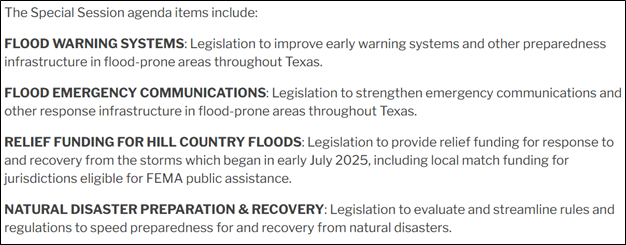Sirens Delayed Until Next Flood Season... Here's The Whole Scoop
- Stevie Quilo

- Aug 6
- 6 min read

The 2025 flash flood season has been Texas’ deadliest in over a decade, and it is only halfway through the storm. Risk of flooding peaks annually each summer, June through September. With two months of this deadly flood season still ahead of us, and the tragic 1998 Del Rio flood in our rearview mirror, there is a sense of urgency to reactivate the Emergency Warning Siren System. The City Council voted to approve the project but delayed funding until after the state’s special legislative session.
Widespread downpours in San Antonio, Dallas, and Houston killed nearly a dozen people by June 12, 2025. In early July 2025, Central Texas was hit with an onslaught of water that led to the deaths of more than 135 people in Hill Country. Texas Lt. Gov. Dan Patrick was quoted saying “If you had sirens blasting… and if people had known ‘if you hear a siren get to high ground,’ maybe that would have saved some lives.”
If passed, the bills proposed in this special legislative session could mean state funding to help facilitate the project. However, it is not guaranteed. The majority of the bills' language specifically limits the aid to “Hill Country.” Del Rio lies at the end of “Flash Flood Alley,” but does not fall within the Hill Country. Flash Flood Alley is known as the stretch of land from roughly Dallas down to Del Rio, where a unique combination of steep slopes, non-porous soil, and colliding weather patterns make it more vulnerable to quickly accumulating water.

Prior to the start of the special legislative session, City Manager Shawna Burkhart advocated for Del Rio to be included in the state aid. During the July 22 City Council Meeting, Del Rio discussed a multi-option plan for a total cost of roughly $520,000. Burkhart confirmed the city has $177,000 available in Certificate of Obligation (CO) funds that could be used as a grant match. Burkhart said, if grant funding becomes available, and "if it requires a match, I would hate to spend the money ahead of time."



The recommendation was: “provide 14 working sirens placed throughout the community which can be activated using one central system. The outdoor sirens would allow Emergency Management to use tone, custom professionally recorded messages in a sound booth, or live public address (P.A.).”
The plan, which the council approved on July 22, involves three separate components: repairing existing equipment to create a central activation system, upgrading five non-operational sirens, and replacing nine older ones with new, more powerful models. These new sirens would have an approximate 1-mile range in a 360-degree direction, strategically placing them in locations that could be heard from county property, such as the vulnerable floodplain Vega Verde neighborhood.
This joint interest makes the county a potential partner in the funding effort. The county has confirmed their interest in providing funding for the project, though their level of contribution will depend upon the final siren locations selected. However, Burkhart stated: "Before I request funds from the county, I really need to find out what the state is going to do. I do believe [Val Verde County] would want to be a partner in this effort.”

Texas Bill HB242 would require municipalities and counties in flood-risk zones to install, maintain, and operate outdoor warning sirens equipped with water-level sensors and solar-powered backup energy sources. Texas Bill HB136 proposes a TDEM (Texas Division of Emergency Management) grant program to fund the purchase, construction, maintenance, and training for emergency communication equipment (such as sirens) and infrastructure for first responders.
These new laws are set to take effect on September 1, 2025. However, this does not mean funding is immediately available. TDEM must first establish an administrative framework for the program, which will take additional time. As a result, grant applications are not expected to be available until well after the effective date, pushing potential funding into 2026 at the earliest.
Del Rio is unsure if it is even eligible for the grant program, as the bill is titled "Hill Country 2025 Flood Response Grant Program." More waiting time will be required to participate in the grant application and approval process with the state. If a grant is secured, the local government will still have to go through a lengthy process of bidding, contracting, and installing the sirens. The bureaucratic timeline makes it a race against the clock to get sirens installed before the 2026 summer flash flood season.

After the flood of 1998, which claimed 9 lives, sirens were installed throughout Del Rio. But they went out of service after less than 20 years of use. In 2018, a proposal to reinstall sirens was included in the city's budget but was later removed due to financial constraints. This situation mirrors that of Kerr County, where other counties along the Guadalupe River had invested in sirens, but Kerr County declined, citing a lack of funds.
Del Rio’s emergency sirens have been non-operational for years. On July 22, 2025, City council recognized sirens as "a need, not a want." It appears some of the old sirens broke down and required mechanical/electrical repairs that were not completed, and one-by-one the sirens went out of service, until the entire system was turned-off. Now, the sirens are out-of-date and incompatible with present-day software. All existing sirens require upgrades and repair or compete replacement.

On July 15, a concerned citizen wrote into a city councilperson, asking why the sirens were shut down. She wished to remain anonymous but shared her letter with Del Rio News Network. The concerned citizen has lived in the Buena Vista area for a decade and used to hear the city testing the siren system every Saturday afternoon, but for years now the sirens have been silent.
Her letter read: “In recent horrific events, we must learn from all experiences (especially the bad experiences) to limit all risks. We need to stop reacting and become proactive in addressing city issues. Why are we waiting for matters to unfold? In the last ten years, I have questioned many aspects of Del Rio’s city and school district actions, but why take away something that works and could save lives?”
“Mother Nature is not always kind to Del Rio,” the letter went on. “Though I do not like to lean toward hysteria, I do believe in being prepared and having a plan in place, along with communication… I am sure the decision to stop the siren drills is related to cost, but if something unfortunate happens, the lawsuits will be more expensive than the siren drills by millions. There is no price you can put on a life.”
Even though the delay in getting new emergency sirens might seem like a setback, it's important to recognize that the City of Del Rio has been actively working on a comprehensive flood management strategy. Sirens are just one piece of the puzzle. The city has been focused on other critical areas, like digital alert systems and major infrastructure upgrades. For example, they are investing millions in major projects like the Carranza Park and Barrio San Felipe drainage. Del Rio is spending money on proactive stormwater management to stop flooding before it starts.

Del Rio offers “Regroup” alerts, where residents can sign up for call/text/email notifications. Amanda Aldaco
Emergency Management Coordinator said there are about 3,500 residents signed up for Regroup, only 10% of the population. Aldaco said she is actively canvassing and recruiting sign-ups. There are 31,000+ residents that still need to be accounted for within the Regroup system.
Another challenge that affects this area, as in many rural communities, is the lack of reliable internet and data service. Especially during bad weather or power outages, cell phones and computers should not be the sole source of emergency alerts. Chad Berginnis, Executive Director of the Association of State Floodplain Managers, was quoted saying: “We’ve gotta meet people where they’re at… To have redundancy in your approach is a good thing.”
The City of Del Rio said: “Experts recommend citizens have multiple methods of obtaining weather warnings, including a mobile/online platform to obtain notifications, outdoor sirens, and NOAA weather radios. The proposed solution provides the City with two avenues to notify citizens of impending weather alerts by providing citizens access to an app that will push out emergency notifications along with outside sirens that use tone, custom professionally recorded messages in a sound booth, or live public announcements.”
The City Council has approved the siren project but has delayed funding while awaiting the results of a special state legislative session. Meanwhile, the city has been making strategic investments in long-term flood prevention through drainage project and has implemented a digital alert system. The city is playing whack-a-mole with crisis management projects, expending exorbitant funds trying to fix the water, wastewater, and drainage systems. Stuck between a rock and a hard place, the city is left reliant upon the state for support. Burkhart said, the city should not have to delay for too long, "waiting several months, not several years."











.png)









Commenti